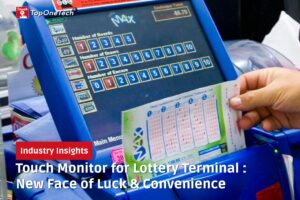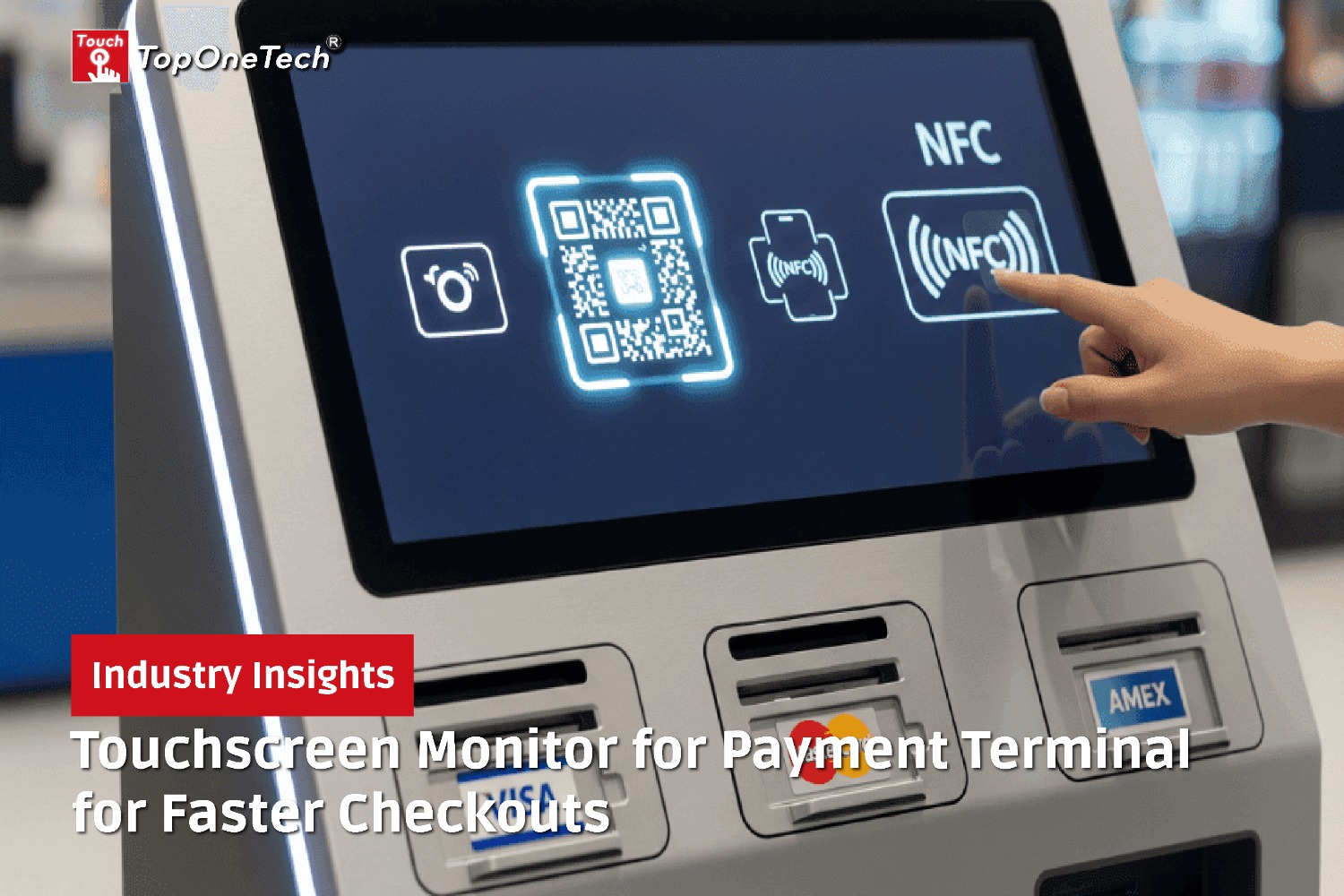
For generations, the lottery has offered people an exciting chance at fortune. Whether it’s picking numbers for a jackpot draw or buying a scratch card, the excitement of the unknown draws millions. But in the digital age, traditional paper-based methods are giving way to faster, more intuitive, and user-friendly systems. At the center of this transformation is the touch monitor for lottery terminal—a technological innovation that’s redefining how people play and interact with lottery systems.
Gone are the days of waiting in line or fumbling with paper slips. With a sleek touch interface, modern lottery terminals now offer a seamless self-service experience. This transition not only improves efficiency but also caters to the growing consumer demand for convenience, speed, and minimal contact—especially in public environments.
What is a Touch Monitor for Lottery Terminal?
A touch monitor for a lottery terminal is a specialized display unit designed to facilitate human interaction with lottery machines through intuitive touch input. This monitor functions as the interface between the user and the terminal’s software, allowing them to browse lottery games, select numbers, check winning combinations, scan previous tickets, and even make payments—often without the need for staff assistance.
These monitors are built with industrial-grade components to ensure longevity, precision, and high responsiveness. They are typically embedded into kiosks or counter-mounted systems and come in different sizes depending on the application. The integration of PCAP (Projected Capacitive) touch technology allows for multi-touch functionality and smooth operation, similar to smartphones and tablets, making it familiar and easy for players of all ages to use.
Touch Monitor for Lottery Terminal – The Evolution of Lottery Terminals: From Paper to Digital
Lottery terminals have seen significant changes over the past few decades. Traditionally, purchasing a lottery ticket involved interacting with a clerk, selecting numbers manually on a paper slip, and waiting for the ticket to be printed. This method, while effective, was time-consuming and often prone to human error.
As technology advanced, self-service lottery kiosks began to emerge, offering a more efficient and streamlined way for users to play. The introduction of digital touch monitors into these systems allowed for intuitive interactions, faster transactions, and a more personalized user experience. Players could now see game previews, use quick-pick options, or explore multiple game types without relying on an attendant.
The pandemic further accelerated the adoption of self-service technologies, with consumers preferring contactless interactions. As a result, the integration of touch monitors in lottery terminals became not only a convenience but a necessity, paving the way for smarter, faster, and more hygienic gaming environments.
Top Features of Touch Monitor for Lottery Terminal
1. Touch Monitor for Lottery Terminal – High-Resolution Display for Clear Visibility
In a game where choosing the right number can change your life, visibility is everything. Touch monitors for lottery terminals are equipped with high-resolution screens—typically Full HD (1920×1080) or higher—to ensure that text, numbers, and graphics are sharp and easily readable. This clarity is especially important in busy retail environments or low-light settings where users need to make quick decisions.
High brightness and vivid color contrast ensure that information is legible even in areas with direct sunlight or harsh indoor lighting. Combined with well-designed UI elements, these displays create an immersive experience that engages users and encourages longer interaction.
2. Durable and Scratch-Resistant Surface
Given that lottery terminals are located in high-traffic public areas such as convenience stores, supermarkets, and transit stations, the monitor’s surface must withstand constant use. That’s why these displays often feature tempered glass and scratch-resistant coatings, making them durable against keys, rings, or other objects that might come into contact with the screen.
Some units also include anti-glare and anti-fingerprint coatings to reduce smudges and maintain screen clarity over time. This ensures the display remains in excellent condition even after thousands of uses, minimizing maintenance and repair costs for operators.
3. Responsive Multi-Touch Capability
Modern touch monitors support multi-touch gestures, allowing users to swipe, scroll, and tap just like they would on a smartphone or tablet. This familiar user experience eliminates the learning curve and makes navigating lottery systems intuitive. Whether zooming in on numbers or toggling between game options, users benefit from a fluid, responsive interface.
Moreover, PCAP technology supports operation even with gloved hands or slight moisture on the screen—essential for environments with varying temperature and hygiene needs.
4. Compact and Sleek Form Factor
Touch monitors are available in multiple sizes, ranging from compact 10.1-inch models to larger 21.5-inch versions. This versatility allows them to fit seamlessly into different kiosk designs, including countertop, wall-mounted, or freestanding terminals.
The open frame or enclosed frame designs enable easy customization, making it possible for lottery operators and OEMs to integrate the screens into their unique housing without compromising aesthetics or functionality.
5. Easy Integration with POS and Lottery Software
Lottery terminals typically involve multiple hardware and software components—barcode scanners, receipt printers, cash acceptors, and lottery servers. A good touch monitor must seamlessly integrate with these systems. Most lottery touchscreen monitors are designed with USB, HDMI, and RS232 interfaces, ensuring plug-and-play compatibility with existing setups.
This makes it easier for system integrators and lottery providers to deploy and scale terminals quickly without extensive software development or hardware upgrades.
Benefits of Using Touch Monitor for Lottery Terminal
1. Enhanced User Experience
One of the biggest advantages of using touch monitors in lottery systems is the improved player experience. Users appreciate having control over their interaction—whether they’re browsing games, entering numbers, or reviewing past results. The intuitive nature of touchscreens fosters engagement and increases satisfaction, especially for tech-savvy and younger demographics.
Moreover, interactive interfaces make it easier for new users to understand how to play different games, reducing hesitation and encouraging repeat participation.
2. Increased Efficiency and Speed
Touchscreen lottery terminals streamline the entire transaction process. Users can complete multiple actions—game selection, number entry, ticket printing, and payment—in just a few taps. This reduces wait times, improves customer throughput, and enhances operational efficiency in busy retail settings.
By minimizing the need for staff involvement, businesses can serve more customers with fewer resources, especially during peak hours or special lottery events.
3. Improved Accessibility for All
Modern touch monitors are designed with accessibility in mind. Features like adjustable font sizes, high-contrast modes, and audio assistance help accommodate individuals with visual or motor impairments. This inclusive design ensures that the lottery experience is accessible to everyone, regardless of age or ability.
By making terminals user-friendly for a diverse audience, lottery providers can expand their customer base and promote social inclusivity.
4. Reduced Operational Costs
Self-service lottery terminals with touch monitors significantly reduce the need for dedicated staff to handle ticket sales. This not only cuts labor costs but also lowers the risk of human error during transactions. Additionally, touch monitors are built to last, with minimal maintenance required over years of operation—resulting in lower total cost of ownership.
Furthermore, centralized control of content updates and diagnostics allows providers to monitor terminal performance remotely, saving time and money on servicing.
5. Real-Time Content Updates
Touchscreen terminals allow for dynamic content delivery. Additionally, lottery providers can instantly update game listings, display current jackpot amounts, and promote limited-time offers or new products through the monitor’s interface.
This real-time capability keeps the system fresh and relevant, encouraging more frequent engagement and enabling cross-promotional opportunities that drive revenue.
Popular Use Cases: Where Are Touch Lottery Terminals Being Used?
Touch monitors are versatile and adaptable, making them suitable for a variety of environments:
-
Retail Stores and Supermarkets: In-store lottery terminals with touchscreens allow customers to quickly purchase tickets or check results while shopping. Moreover, the convenience of self-service improves customer satisfaction and boosts impulse purchases.
-
Standalone Lottery Kiosks: These are often placed in high-traffic areas like malls, train stations, or entertainment venues. Additionally, designed to operate without supervision, these kiosks provide 24/7 access to lottery services, making it easier for users to play on the go.
-
Casinos and Gaming Halls: Touch monitor lottery terminals are integrated into broader gaming ecosystems. They provide an additional channel for customer engagement, increasing playtime and overall spend per visit.
-
Gas Stations and Convenience Stores: Space is often limited in these locations, making compact touchscreen terminals an ideal solution. Customers can play the lottery while refueling or buying groceries, creating a seamless, one-stop experience.
Touch Monitor Technology Behind Lottery Terminals
The core of a modern lottery terminal lies in its technology, and the touch monitor plays a critical role in ensuring smooth operation and user satisfaction. Key technologies include:
Projected Capacitive Touch (PCAP)
This is the gold standard for interactive displays. PCAP touchscreens offer superior touch sensitivity, durability, and multi-touch support. Moreover, they’re responsive even to light touches, gloved hands, or minimal moisture—making them ideal for public environments with diverse user behaviors.
Anti-Glare and Anti-Fingerprint Coatings
Manufacturers treat many lottery monitors with special coatings to ensure maximum visibility and hygiene by reducing reflections and resisting smudges. Furthermore, these coatings help maintain screen clarity over long periods and reduce the frequency of cleaning.
Wide Viewing Angles and High Brightness
Whether a player is standing directly in front of the terminal or slightly off to the side, they should be able to view the screen clearly. Moreover, monitors with wide-angle IPS panels and high brightness (often 1000 nits or more) provide consistent color and clarity from any angle, ensuring that content remains legible in all lighting conditions.
Waterproof and Dustproof Designs
Manufacturers seal touch monitors with IP65-rated front panels to protect them against dust, spills, and other environmental hazards. This makes them ideal for both indoor and semi-outdoor applications where reliability is crucial.
Touch Monitor for Lottery Terminal – Choose Top One Tech, The Right Supplier for Your Lottery Terminal Touch Monitor
Selecting the right partner for your lottery terminal needs is crucial to long-term success. Top One Tech stands out as a leading supplier of high-performance touch monitors designed specifically for gaming and lottery applications.
With years of experience in the gaming and kiosk industries, Top One Tech understands the demands of public-facing terminals. Moreover, our touch monitors offer:
-
Wide Size Range: From 10.1 inches to over 21 inches, suitable for any lottery setup.
-
PCAP Technology: Delivering responsive, multi-touch performance even in rugged environments.
-
Custom Design Support: Offering open-frame or closed-frame models tailored to your unique enclosure.
-
Industrial Durability: Scratch-resistant, anti-glare surfaces with IP-rated protection.
-
Global Compatibility: Interfaces and firmware support for major lottery systems and POS software.
-
Responsive Customer Service: Dedicated technical support and consultation throughout your project lifecycle.
If you’re aiming to enhance player interaction, improve operational efficiency, and stay ahead of digital trends, Top One Tech delivers the tools you need to succeed.
Conclusion: A Smarter Way to Play
As lottery systems evolve, the integration of touch monitors into lottery terminals is proving to be more than just a technological trend—it’s a necessary step forward. These displays offer unmatched convenience, enhanced user experiences, and robust functionality for both players and operators.
Additionally, from improving accessibility and speed to enabling dynamic promotions and self-service capabilities, touchscreen lottery terminals are revolutionizing how we play. Furthermore, for those looking to stay competitive and future-ready, now is the perfect time to invest in this game-changing technology.
Are you ready to embrace the new face of luck and convenience?
Make the smart move with touch monitors for lottery terminals—where every tap brings a new opportunity.
Top One Tech can customize Touch Monitor for Your Casino Gaming Machine and we can also customize The Casino Gaming Machine Metal Cabinet, crafted by our subsidiary company, Top One Tech Metal, specially made for your application scenarios.
Don’t hesitate to contact us for further assistance :
Whatsapp/Call us at : +86 13631610695
Email : sales@toponetech.cn
See Also : Our Wide Range of Casino/Gaming Touch Monitor Products




